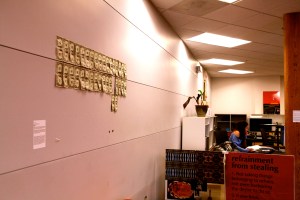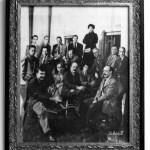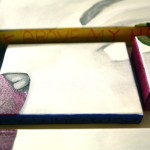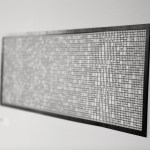Restraining Order: The Art of Self-Control
Tomorrow night is the opening of my lab’s art show on self-control, and we interviewed a few of our artists to get their take on the project and self-control in general.
Restraining Order: The Art of Self-Control from Advanced Hindsight on Vimeo.
See more on the Artistically Irrational project here.
Call for Artists to Respond to Research on Self-control
 Artists from around the world are invited to attend a discussion on self-control entitled “Restraining Order: The Art of Self-Control” as the next part of the “Artistically Irrational” exhibition series on Wednesday, September 26th at 7 PM EST. (Artists who do not live within driving distance of Durham, NC will be able to watch online.)
Artists from around the world are invited to attend a discussion on self-control entitled “Restraining Order: The Art of Self-Control” as the next part of the “Artistically Irrational” exhibition series on Wednesday, September 26th at 7 PM EST. (Artists who do not live within driving distance of Durham, NC will be able to watch online.)
Interested artists should RSVP to the curator, Catherine Howard, at artisticallyirrational@gmail.com by Monday, September 24th by 9 PM.
After the forum, artists interested in creating artwork in response to the research will submit a 1-page proposal and 2-3 digital images of past work. To be considered, applications must be submitted by Friday, October 5th at 9 PM.
Artists will be notified if they are selected to participate by Monday, October 8th and will receive a $100 stipend to complete their piece. There is no limitation to the style or media of pieces created for “Restraining Order,” but the exhibit includes an exercise in self-control embedded in the artistic process. All selected artists will be required to work on their pieces for the entire period leading up to the due date and will send weekly photos to document the progression of the piece. All completed art works must be received by Friday, December 7th.
Artwork created for “Restraining Order” will be on display at the Center for Advanced Hindsight from December 14th, 2012 to February 22nd, 2013 with a reception on Saturday, January 26th, 2013 from 6-9 pm.
Artists will retain all rights to their piece. Works will be returned to artists after the exhibit by March 15th, 2013. If the piece is purchased, the $100 stipend will be deducted from the purchase price.
Important Deadlines
September 26, 7pm — Forum at the Center for Advanced Hindsight
October 5, 9pm — Deadline to submit artwork proposal
December 7, 9pm — Drop-off deadline
January 26, 6–9pm — Opening reception at the CAH
Call for Artists to Respond to Research on Self-control
Artists from around the world are invited to attend a discussion on self-control entitled “Restraining Order: The Art of Self-Control” as the next part of the “Artistically Irrational” exhibition series on Wednesday, September 26th at 7 PM EST. (Artists who do not live within driving distance of Durham, NC will be able to watch the forum streaming online.)
Interested artists should RSVP to the curator, Catherine Howard, at artisticallyirrational@gmail.com by Monday, September 24th by 9 PM.
After the forum, artists interested in creating artwork in response to the research will submit a 1-page proposal and 2-3 digital images of past work. To be considered, applications must be submitted by Friday, October 5th at 9 PM.
Artists will be notified if they are selected to participate by Monday, October 8th and will receive a $100 stipend to complete their piece. There is no limitation to the style or media of pieces created for “Restraining Order,” but the exhibit includes an exercise in self-control embedded in the artistic process. All selected artists will be required to work on their pieces for the entire period leading up to the due date and will send weekly photos to document the progression of the piece. All completed art works must be received by Friday, December 7th.
Artwork created for “Restraining Order” will be on display at the Center for Advanced Hindsight from December 14th, 2012 to February 22nd, 2013 with a reception on Saturday, January 26th, 2013 from 6-9 pm.
Artists will retain all rights to their piece. Works will be returned to artists after the exhibit by March 15th, 2013. If the piece is purchased, the $100 stipend will be deducted from the purchase price.
Important Deadlines
September 26, 7pm — Forum at the Center for Advanced Hindsight
October 5, 9pm — Deadline to submit artwork proposal
December 7, 9pm — Drop-off deadline
January 26, 6–9pm — Opening reception at the CAH
I ______ a dollar?
As part of the PoorQuality: Inequality exhibition that is currently on display at the CAH, we are showing a piece of art by Jody Servon entitled “I ______ a dollar.” This piece started out as one hundred $1 bills stuck flat against the wall. The bills hung there in a simple, uniform shape, Washington after Washington. The money was there for the taking, but only if you needed it. Jody asked viewers to think about the value of a single dollar, to contemplate their “needs” in relation to their “wants.”

“My hope is for people to actively consider whether or not having this single dollar will make a difference in his or her life, or if they feel the dollar is better left for someone else who needs it more. Perhaps the invitation to take free money will eclipse the question of want vs. need.”
A week went by, and one dollar disappeared. Afraid that the piece would dissolve too quickly, one lab member replaced the missing dollar. The art was whole again. More time went by, and another lab member needed change for the vending machine. So she took five singles and left her $5 bill. We treated the piece as if it was our own, moving bills around but preserving its integrity. The wall of money remained, for the most part, intact.
We asked Jody about her expectations for the piece.
“Among the scenarios I considered were one person swiping all of the dollars on the first day, the dollars slowly disappearing one-by-one, someone rearranging the dollars in a different design, or somewhat disappointingly, the piece remaining on the wall untouched.”
But the wall did not remain untouched, and one day it encountered a group of guests who came in on a particularly quiet day and left with most of the money. Sure, we were a little annoyed; our precious wall had been ransacked. But that was its purpose, and we laughed it off. At least we had a good story, right?
Some time later, one of the ransackers returned. This time, the CAH was bustling, full of people and lively conversation. He walked in, saw the commotion, and hesitated for just a moment before telling us that he was hungry. We don’t have any food here, but there are plenty of restaurants down the street, we told him. Of course, he was not asking where he could buy food. We knew that. But none of us jumped up to offer what was left of the money hanging on the wall. It was art, after all.
Here we were, hosting an exhibit on “inequality,” and there was no doubt that this man lay farther down on the distribution of wealth than any of us. And in all of our musings on the exhibit, never did we think that we might find ourselves faced with the perfect case of actual inequality.
Until this moment, we had primarily used and conceived of the wall of bills as a cashier. Yes, we contemplated whether we needed or simply wanted a dollar. But most of us don’t need a dollar. In the end, this experience may be the ultimate experiment of our project. And we stumbled into it unintentionally, or rather, he stumbled into our gallery.
A collaboration between Dan Ariely & Aline Grüneisen
The PoorQuality: Inequality Exhibit will be up until the end of August (and we will see whether there are any dollar bills left).PoorQuality: Inequality Opening Reception
innovative and engaging artwork.
social and economic inequality.
wealth distribution.
what is so taxing about taxation?
Opening Reception: June 22, 2012 from 6 – 10 PM at the CAH
Featuring drinks, classy appetizers, and the fabulous DJ Mike B
With no limitation to the style or media of pieces created for PoorQuality: Inequality, a portion of the artists, which included sculptors, painters, book artists, video artists, and photographers, branched out stylistically from their normal medium, while others pushed conceptual boundaries.
Some chose to explore how to visualize analytical data. Suzanne Broughel used color to interpret the U.S. racial wealth gap by decorating a white bed sheet “canvas” with coin marks made by dipping quarters and pennies in liquid foundation makeup and pressing them on the fabric. Peter Lisignoli, an MFA student at Duke University, became interested in how one represents the absence of food. He photographed a Quick-n-Go market to rethink how space and time are rendered by such a space. Despite his efforts to tackle the social issue of food inequality, his project changed focus toward the ghettoizing gaze of the surveillance camera.
Other artists explored the capacity for art to spark an emotional response to the research presented by the Center for Advanced Hindsight. Leslie Salzillo’s “The Rise of Soraya M (What Does that Make Her?)” honors all women who have suffered small and great injustices created by the unequal legal and social double standards misinterpreted to dehumanize women.
June 1, 2012 – August 31, 2012
Open to the public Monday – Friday 10 AM – 3 PM
The Artistically Irrational Exhibition Series
When we decided to create the Artistically Irrational series, we hoped to catalyze the scientific process by bringing art directly into the place where we work and think.
Behavioral research is an indispensable tool for social scientists looking to understand and comment on the fascinating world in which we find ourselves. Controlled experiments allow us to measure and reflect on issues ranging from injustice to advertising, the taste of beer to medical conflicts of interest, and even social networks like Facebook or Twitter. Such experiments allow us to reliably test whether our intuitions about the world are true and figure out when, how, and why we are wrong. Art fills a similar void, filtering ideas and motivations through individual sensibilities, then taking the result and crystallizing it into something more or less universal. And although there are many differences between the worlds of Science and Art, both can provide useful social commentary. In fact, it is these very differences that invite a discussion between the two. We hope that, through this project, the scientific and artistic approaches can fertilize one another and expand the lines of communication between two fields that have so much in common but speak to one another so rarely.
The Artistically Irrational exhibition series is essentially an experiment in feedback loops. Each project begins with a discussion of social science research on a particular topic and a request for artists to express themselves through their art. Then, surrounded by the fruits of their labor, we get to further reflect on our research through their eyes, using their insights to enrich the meaning of our studies.
~ –– ~ –– ~ –– ~ –– ~ –– ~ –– ~ –– ~ –– ~ –– ~ ––
Creative Dishonesty: Cheat Codes
The first show revolved around our research on cheating and dishonesty. After I spoke to a group of artists, they went back to their studios and put together their interpretations of our findings. They came back with a range of pieces exploring the nature of dishonesty – especially as it related to their own practices. Several artists investigated the moral status of artistic “borrowing” and the thin line between appropriation and flat-out plagiarism. One artist played with the idea of citation, which is virtually nonexistent in art but is a practice with rigid requirements in the sciences (see APA, 2010). Another considered how the mere label of “art” affects how we experience something, whether it is a flattened steel grid or a topsy turvy urinal. Other artists examined the spiral of bad decisions that can spring from one little transgression, and how moral reminders or cleansing rituals can help us correct our misdeeds and start over. Many explored the ways that we lie to others and ourselves, how we hold distorted worldviews and memories – and the rationalizations that go along with them.
All of these pieces revolved around an interesting finding of our research: the tendency of creatives to be less honest than non-creatives. As David Hockney said, “the moment you cheat for the sake of beauty, you know you’re an artist.”
A Sample from the Show:
(click on images for larger view)
Photos taken by Aline Grüneisen
~ –– ~ –– ~ –– ~ –– ~ –– ~ –– ~ –– ~ –– ~ –– ~ ––
And because the Creative Dishonesty exhibit was such a success, we decided to host another art show, this time following the theme of social and economic inequality, wealth distribution, and what is so taxing about taxation. This exhibit, PoorQuality: Inequality has just been installed and will accompany me in the Center for Advanced Hindsight until August 31.
If you can make it, I highly recommend coming to our opening reception on June 22 from 6 – 10 PM.
For more photos and information about the Artistically Irrational exhibition series, see our website or contact curator Catherine Howard at artisticallyirrational@gmail.com
 To all those who attended the PoorQuality forum last night, thanks for participating!
To all those who attended the PoorQuality forum last night, thanks for participating!
For more information about the exhibit, please see our Artistically Irrational website
PoorQuality: Inequality
 Call for Artists to respond to research on inequality
Call for Artists to respond to research on inequality
Hosted by Dan Ariely and the Center for Advanced Hindsight
Artists from around the world are invited to attend a discussion on social and economic inequality (from the lab that hosted the “Creative Dishonesty” project), on Wednesday, February 22nd at 7 PM EST. (Artists who do not live within driving distance of Durham, NC will watch the forum streaming live online.)
Interested artists are to RSVP to the curator, Catherine Howard, at creativedishonesty@gmail.com by Tuesday, February 21st at 9 PM EST
After the forum, artists interested in creating artwork in response to the research will complete an online application, including a 1-page explanation of the artist’s creative process and 2-3 digital images of past work. To be considered, applications must be submitted by Monday, February 27th at 9 PM.
Artists will be notified if they are selected to participate by February 29th and will receive a $100 stipend to complete their piece. There is no limitation to the style or media of pieces created for “PoorQuality” but all work must be completed by May 5th.
Artwork created for “PoorQuality” will be on display at the Center for Advanced Hindsight from June 1st to August 31st with a reception on June 22nd. An exhibit catalogue, including responses and reflections by the artists and the researchers, will be published. Each artist will receive a copy.
Artists will retain all rights to their piece. Works will be returned to artists after the exhibit by September 15th, 2012. If the piece is purchased, the $100 stipend will be deducted from the purchase price.
Important Deadlines
Feb 22, 7 PM – “PoorQuality: Inequality” forum at the Center for Advanced Hindsight
Feb 27, 9 PM – Deadline to apply for participation
Feb 29, 9 AM – Selected artists will be notified
May 5, 9 PM – Drop-off deadline
Jun 22, 6 PM – 10 PM – Opening reception at the Center for Advanced Hindsight
For more information about the “PoorQuality” project, contact curator Catherine Howard at creativedishonesty@gmail.com.
Learn more about this research at danariely.com
UPDATE: We have a new website fully devoted to our “Artistically Irrational” art series.
Check it out here: http://artisticallyirrational.ssri.duke.edu/
Creative Dishonesty
 The Center for Advanced Hindsight at Duke University is
The Center for Advanced Hindsight at Duke University is
Pleased to Coordinate and Host the Exhibition
Creative Dishonesty: Cheat Codes
on display at 2024 W Main St, Bay C, Durham, NC from
December 3, 2011 to January 31, 2012.
with an opening reception on
December 16, 2011 6 – 10 PM
As a magnanimous gesture of support for artistic ingenuity and creative perspectives, twenty artists were invited to create innovative and engaging artwork in response to research on behavioral economics, dishonesty, and cheating after attending an interactive forum at the Center for Advanced Hindsight.
With no limitation to the style or media of pieces created for “Creative Dishonesty: Cheat Codes,” a portion of the artists, which included sculptors, painters, and photographers, branched out stylistically from their normal medium, while others pushed conceptual boundaries.
Albert Gilewicz, a sculptor, utilized “Ethos” bottled water as the foundation for a sculpture exploring the truth behind branding and corporate marketing, compelling the viewer to confront the reality of selling their morality for the sum total of $0.05 donated to the development of drinkable water sources in Africa.
Artist Kerry Cox created an interactive installation that questions the nature of imagery as “moral” or “immoral” through audience participation. In a similar vein, Bruce Mitchell and Adrian Schlesinger created projects inquire how to classify an image as “art” after mechanical tools are used to enlarge, project, draft, and print.
Meet these artists and many others at the opening reception on December 16th from 6-10 PM! Pick their brains about the relationship between creativity, honesty, cheating, and the “fudge factor”. Join us on Third Friday for delicious food, wine, thoughtful artwork, and lively conversation at the Center for Advanced Hindsight, 2024 W Main St, Bay C, Durham, NC.
An exhibit catalogue, including reflections by the artists alongside responses from the curator and the researchers at the Center for Advanced Hindsight, will be published and available for purchase.
For more information about the Creative Dishonesty project, contact curator Catherine Howard atcreativedishonesty@gmail.com.
Cheat Codes: Calling all Artists
 Artists from around the world are invited to attend a discussion about behavioral economics, dishonesty and cheating at the Center for Advanced Hindsight on October 25 at 7:30 PM EST. (Artists who do not live within driving distance of Durham, NC can watch the forum streaming live online.)
Artists from around the world are invited to attend a discussion about behavioral economics, dishonesty and cheating at the Center for Advanced Hindsight on October 25 at 7:30 PM EST. (Artists who do not live within driving distance of Durham, NC can watch the forum streaming live online.)
Interested artists should RSVP to Catherine Howard (irrationalcreativity@gmail.com) by October 24 by 9 PM for driving directions and/or the online streaming link.
After the forum, applications will be circulated to artists interested in creating artwork to depict their reflection on cheating and dishonesty. Applications will include a brief explanation of the artist’s creative process and 2-3 digital images of past work.
Please submit applications to Catherine Howard at irrationalcreativity@gmail.com by October 28.
Artists will be notified if they are selected to participate by October 29 and will receive a $100 stipend to complete their piece. There is no limitation to the style or media of pieces created for “Cheat Codes,” but all work must be completed by November 26.
Artwork created for “Cheat Codes” will be on display the Center for Advanced Hindsight from December 3, 2011 to January 31, 2012. An exhibit catalogue / book, including responses and reflections by the artists and the researchers at The Center For Advanced Hindsight, will be published. Each artist will receive a copy.
Artists will retain all rights to their piece. Works will be returned to artists after the exhibit by February 15, 2012. If the piece is purchased, the $100 stipend will be deducted from the purchase price.
Important Deadlines
Oct 25, 7:30 PM: Dishonesty forum at the Center for Advanced Hindsight
Oct 28, 9 PM: Deadline to apply for participation in “Dishonesty”
Oct 29, 9 PM: Selected artists will be notified
Nov 26, 9 PM: Drop-off deadline
Dec 16, 6 – 10 PM: Opening reception at the Center for Advanced Hindsight
For more information about the Creative Dishonesty project, contact curator Catherine Howard at irrationalcreativity@gmail.com.
 Tweet
Tweet  Like
Like 


